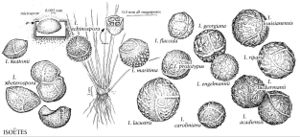Isoëtes tuckermanii
in A. Gray,Manual ed. 5 676. 1867.
Plants aquatic, occasionally emergent. Rootstock nearly globose 2 (–3) -lobed. Leaves evergreen, olive green to reddish-brown, pale toward base, spirally arranged, to 20 cm, pliant to rigid, gradually tapering to tip. Velum covering less than 1/2 of sporangium. Sporangium wall brown-streaked. Megaspores white, 450–650 μm diam., reticulate with ridges having irregular and roughened crests; girdle densely papillate. Microspores gray in mass, 25–35 μm, spinulose. 2n = 44.
Phenology: Spores mature in late summer.
Habitat: Slightly acid lakes, ponds, and streams
Distribution

N.B., Nfld. and Labr. (Nfld.), N.S., Ont., Que., Conn., Maine, Mass., N.H., N.J., N.Y., R.I., Vt.
Discussion
Isoëtes tuckermanii may be an allotetraploid like I. riparia, but it appears to have had different parental species. Variation may also have resulted from multiple allotetraploid origins. Typical plants of I. tuckermanii have thin, soft leaves. More northern plants, referred to as I. tuckermanii var. borealis A. A. Eaton, have thick, stiff leaves.
Isoëtes tuckermanii hybridizes with I. echinospora; I. engelmannii [ = I. x foveolata A. A. Eaton ex Dodge]; and I. lacustris [ = I. x harveyi A. A. Eaton].
Selected References
None.
